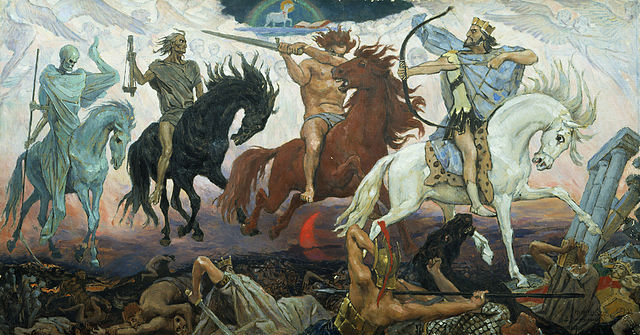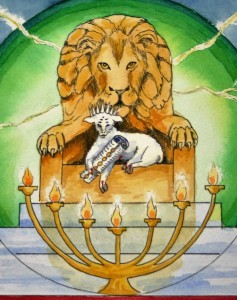I preach the good news of Jesus, including Jesus’ way of radical, nonviolent love. As one might expect, I get some pushback on this. “What about sin?” I hear frequently. “What about God’s judgment?” “What about God’s wrath?”
“What about hell?”
Yes, what about hell? After all, Jesus mentions hell more than anyone else in the New Testament. There’s this handy bit of practical advice, for example: “If your hand causes you to stumble, cut it off; it is better for you to enter life maimed than to have two hands and to go to hell, to the unquenchable fire.” Or this lovely bit of encouragement: “You snakes, you brood of vipers! How can you escape being sentenced to hell?”
I’ll admit that my first thought when I hear these kinds of questions is that if anyone thinks my idea of love doesn’t include ideas of sin and its consequences, they aren’t listening. More on point, though, is this: if we want to understand Jesus on hell, we need to read these Gospel teachings carefully, in context, across the Testaments.
Most of the time in the Gospels, the “hell” Jesus mentions is “Gehenna.” The other times when Jesus refers to a hellish judgment, ideas of “Gehenna” are probably still in the background.
“Gehenna” is a reference to a very particular place—and it’s not some location under the earth run by the devil and staffed by his demons. “Ge-henna” refers to the “valley of Hinnom,” a small valley running along the south and west of the Old City of Jerusalem.
I’ve been there—there’s nothing hellish about it at all. Nor was there in Jesus’ day.
Sometimes you’ll hear that in Jesus’ day there was a perpetually burning garbage dump in the Hinnom valley. But that’s not the case. This idea seems to have originated from a Rabbi centuries after Jesus. In Jesus’ day there was nothing hellish about Gehenna at all.
What was hellish about the valley of Hinnom was its history. There are several Old Testament passages that describe the hellish history of Gehenna. They’re all similar, but to get a taste of hell let’s focus in on one of these—Jeremiah 7, starting with 7:31:
And they [the people of Judah] go on building the high place of Topheth, which is in the valley of the son of Hinnom, to burn their sons and their daughters in the fire—which I [Yahweh, the Lord] did not command, nor did it come into my mind.
Here we learn three key points about Gehenna, the valley of Hinnom.
1) The fires of Gehenna were made by humans, not by God.
In fact, 2) God abhorred the fires of Gehenna.
And why did God so despise the fires of Gehenna? Because 3) they were the epitome of senseless human violence, particularly violence against the most vulnerable.
But there’s more to the story of Jeremiah 7. The people of Judah are appealing to their own special status before God, hoping this will save them from foreign invasion. “The temple of Yahweh is here!” they cry—as if that will help them. “Look,” they say, “we offer all the proper sacrifices!”—as if that will make a difference.
But any special status they think they have is an illusion, all their acts of righteousness are irrelevant, because they are “oppressing the alien, the orphan, and the widow, and shedding innocent blood.” They are committing grave injustices against the most vulnerable among them—of which burning their sons and daughters in the fires of Gehenna was the most horrific.
All this explains why the tables turn at the end of the chapter:
Therefore, the days are surely coming, says the Lord, when it will no more be called Topheth, or the valley of the son of Hinnom, but the valley of Slaughter: for they will bury in Topheth until there is no more room. The corpses of this people will be food for the birds of the air, and for the animals of the earth; and no one will frighten them away. And I will bring to an end the sound of mirth and gladness, the voice of the bride and bridegroom in the cities of Judah and in the streets of Jerusalem; for the land shall become a waste.
It’s a soul-shuddering reference to Jerusalem’s impending doom, the city’s destruction at the hands of the ruthless Babylonian armies. The people’s religiously righteous acts and supposed special status aren’t going to save them.
And all their injustice, all their oppression, all their senseless violence against the most vulnerable? It’s going to rebound against them in equally horrific fashion, until the valley of Hinnom becomes an enduring symbol of God’s judgment on the self-righteous strong who oppress the marginalized weak.
To our three points about Gehenna’s fires above we can now add three more:
4) Gehenna symbolizes God’s judgment, but this divine judgment is not an “angry God directly inflicting violence upon sinners for eternity” judgment.
It’s a 5) “reap what you sow” judgment—if we sow violence, injustice, and oppression, we will reap that violence, injustice, and oppression upon ourselves, in very human, very natural, ways, within human history and not beyond it.
It’s a 6) judgment specifically upon the powerful, those with social or economic or political or religious clout, for the ways in which they oppress and commit violence against the weak, those on the bottom rungs of our social and economic and political and religious hierarchies.
With this background on Gehenna in mind, we can now fully appreciate Jesus’ words on hell in the Gospels.
Jesus isn’t talking about a “literal hell” where unrepentant unbelievers go after they die to be tortured in God’s inferno for all eternity.
He’s talking about the violent consequences of our own violent actions, right here in our lived lives, right here in human history.
He’s talking about such consequences especially for those who use their power to oppress the weak, who live in wealth in indifference to the poor, who have the means to care for the sick and clothe the naked and feed the hungry but refuse to do so, who rest secure in their status and privilege while committing grave injustices against the vulnerable and the marginalized.
And he’s talking in particular to the uber-religious, the people who think they’re on God’s side because they believe the right things or do the right rituals—but they burden others with moral demands while doing nothing to help them, they focus on minor moral issues while neglecting the weightier matters of justice and mercy and allegiance to God above all other powers that be.
These are sobering words, serious warnings, for every age and certainly our own. But all this is right in line with the good news of Jesus and Jesus’ way of love.
After all, there’s nothing more loving, nothing more like Jesus, than standing in solidarity with the powerless, the stepped-upon, the pushed-to-the-side, and standing up to the oppressive powers that be—whatever the cost to ourselves.
And it is this hell of our own harmful actions and their destructive consequences—our sin and all its death—that Jesus has come to save us from. Jesus calls us to leave behind our damaging, violent ways and follow him in his path of compassionate, inclusive, forgiving, self-giving love. If we don’t do this the result will only be death for ourselves, for others, for the world. But if we do this we will find life, full and flourishing life for all.
This is love. This is Jesus. This is good news indeed.
For more on this, see my “Let’s Talk About Hell.”
© Michael W. Pahl



 That’s odd, quite frankly. After all, Jesus was emphatic about what the greatest commandments of God were:
That’s odd, quite frankly. After all, Jesus was emphatic about what the greatest commandments of God were:  I think much of the problem is that we don’t really know the love that Jesus taught, the love that Jesus lived. And if we know this love, we don’t really trust in this love, not really. This can be true of both “sides,” it seems to me, both those who think love alone is the stairway to a heaven of harmonious society, and those who think “love alone” is the highway to a hell of moral relativism.
I think much of the problem is that we don’t really know the love that Jesus taught, the love that Jesus lived. And if we know this love, we don’t really trust in this love, not really. This can be true of both “sides,” it seems to me, both those who think love alone is the stairway to a heaven of harmonious society, and those who think “love alone” is the highway to a hell of moral relativism. Love starts with a stance of openness toward another person. It’s like
Love starts with a stance of openness toward another person. It’s like  And this love is the most practical, the most necessary thing in the world. “
And this love is the most practical, the most necessary thing in the world. “

 Let’s start with the first major vision of Revelation,
Let’s start with the first major vision of Revelation,  And this means there is more than meets the eye in Revelation. All those depictions of God’s judgment being a sort of violent vengeance, a kind of retribution, cannot mean what we think they mean at first glance. God is out to eliminate human sin, evil powers, even death itself—but not human persons. As
And this means there is more than meets the eye in Revelation. All those depictions of God’s judgment being a sort of violent vengeance, a kind of retribution, cannot mean what we think they mean at first glance. God is out to eliminate human sin, evil powers, even death itself—but not human persons. As  Revelation gives us a vision of God’s reign over all things. God reigns as Creator and Sustainer and Redeemer, working out God’s purposes even through all the chaos and conflict on earth. God’s reign of justice and peace through the crucified and risen Jesus is the alternative to the evil powers of our world. (That’s what the “divine throne” and “Lion/Lamb” stuff is all about.)
Revelation gives us a vision of God’s reign over all things. God reigns as Creator and Sustainer and Redeemer, working out God’s purposes even through all the chaos and conflict on earth. God’s reign of justice and peace through the crucified and risen Jesus is the alternative to the evil powers of our world. (That’s what the “divine throne” and “Lion/Lamb” stuff is all about.)